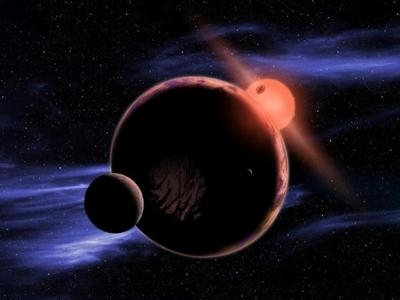Mon, Feb 11, 2013
Research Shows Nearest Planet Suitable For Liquid Water May Be Just 13 Light-Years Away
Using publicly available data from NASA’s Kepler space telescope, astronomers at the Harvard-Smithsonian Center for Astrophysics (CfA) estimate that six percent of red dwarf stars in the galaxy have Earth-size planets in the "habitable zone," the range of distances from a star where the surface temperature of an orbiting planet might be suitable for liquid water.

The majority of the sun's closest stellar neighbors are red dwarfs. Researchers now believe that an Earth-size planet with a moderate temperature may be just 13 light-years away. "We don't know if life could exist on a planet orbiting a red dwarf, but the findings pique my curiosity and leave me wondering if the cosmic cradles of life are more diverse than we humans have imagined," said Natalie Batalha, Kepler mission scientist, NASA's Ames Research Center in Moffett Field, CA.
The research team analyzed 95 planet candidates in the Kepler catalog orbiting 64 red dwarf stars. Most of these candidates aren't the right size or temperature to be considered Earth-like, as defined by the size relative to Earth and the distance from the host star. However, three candidates are both temperate and smaller than twice the size of Earth.
Red dwarf stars are smaller, cooler, and fainter than the sun. An average red dwarf is only one-third as large and one-thousandth as bright as the sun. Consequently, the not too hot or not too cold habitable zone would be much closer to a cooler star than it is to the sun. "This close-in habitable zone around cooler stars makes planets more vulnerable to the effects of stellar flares and gravitational interactions, complicating our understanding of their likely habitability,” said Victoria Meadows, professor at the University of Washington and principal investigator with the NASA Astrobiology Institute. "But, if the planets predicted by this study are indeed found very nearby, then it will make it easier for us to make the challenging observations needed to learn more about them, including whether or not they can or do support life."
The three planetary candidates highlighted in this study are Kepler Object of Interest (KOI) 1422.02, which is 90 percent the size of Earth in a 20-day orbit; KOI-2626.01, 1.4 times the size of Earth in a 38-day orbit; and KOI-854.01, 1.7 times the size of Earth in a 56-day orbit. Located between 300 to 600 light-years away, the three candidates orbit stars with temperatures ranging from 3,400 to 3,500 degrees Kelvin. By comparison, the temperature of the sun is nearly 5,800 degrees Kelvin.
(Image provided by NASA shows artist's concept of planet in orbit around a Red Dwarf star)
FMI: www.nasa.gov
More News
Aero Linx: International Business Aviation Council Ltd IBAC promotes the growth of business aviation, benefiting all sectors of the industry and all regions of the world. As a non->[...]
"During the annual inspection of the B-24 “Diamond Lil” this off-season, we made the determination that 'Lil' needs some new feathers. Due to weathering, the cloth-cove>[...]
Also: Bushcat Woes, Hummingbird 300 SL 4-Seat Heli Kit, Carbon Cub UL The newest Junkers is a faithful recreation that mates a 7-cylinder Verner radial engine to the airframe offer>[...]
Also: Seaplane Pilots Association, Rotax 916’s First Year, Gene Conrad After a decade and a half of struggling with the FAA and other aero-politics, G100UL is in production a>[...]
Also: Martha King Scholarship, Montaer Grows, Textron Updates Pistons, FlySto The FAA is hiring thousands of air traffic controllers, but the window to apply will only be open for >[...]
 ANN's Daily Aero-Linx (04.16.24)
ANN's Daily Aero-Linx (04.16.24) Aero-News: Quote of the Day (04.16.24)
Aero-News: Quote of the Day (04.16.24) Airborne 04.10.24: SnF24!, A50 Heritage Reveal, HeliCycle!, Montaer MC-01
Airborne 04.10.24: SnF24!, A50 Heritage Reveal, HeliCycle!, Montaer MC-01 Airborne 04.12.24: SnF24!, G100UL Is Here, Holy Micro, Plane Tags
Airborne 04.12.24: SnF24!, G100UL Is Here, Holy Micro, Plane Tags Airborne-Flight Training 04.17.24: Feds Need Controllers, Spirit Delay, Redbird
Airborne-Flight Training 04.17.24: Feds Need Controllers, Spirit Delay, Redbird



